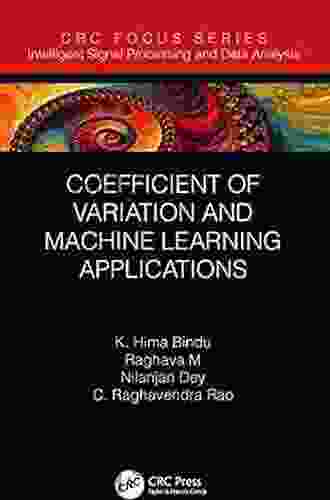Coefficient Of Variation And Machine Learning Applications (Intelligent Signal Processing And Data Analysis)

In the realm of data analysis and signal processing, the coefficient of variation (CV) stands as a pivotal metric for assessing the relative variability within a dataset. This quantitative measure provides insights into the dispersion or spread of data points around the mean, offering valuable information for a wide range of applications in machine learning (ML) and intelligent signal processing.
Definition of Coefficient of Variation
The coefficient of variation is defined as the ratio of the standard deviation (σ) to the mean (μ) of a dataset:
CV = σ / μ
4 out of 5
| Language | : | English |
| File size | : | 22688 KB |
| Text-to-Speech | : | Enabled |
| Enhanced typesetting | : | Enabled |
| Print length | : | 148 pages |
| Screen Reader | : | Supported |
It is expressed as a percentage, allowing for easy interpretation and comparison across different datasets. A lower CV indicates less variability, while a higher CV signifies greater variability.
Applications in Machine Learning and Intelligent Signal Processing
The CV finds extensive use in various ML and intelligent signal processing applications, including:
1. Data Normalization and Standardization:CV can serve as a valuable tool for normalizing and standardizing data. By dividing the standard deviation by the mean, CV brings data points to a common scale, facilitating meaningful comparisons and analysis.
2. Feature Selection:In feature selection, CV can help identify features that contribute significantly to the variability of a dataset. Features with high CV indicate greater potential for discrimination and can be prioritized for further analysis.
3. Anomaly Detection:CV can be leveraged for anomaly detection by identifying data points that deviate significantly from the average variability. This information can assist in flagging outliers or unusual patterns that may require further investigation.
4. Signal Denoising:In intelligent signal processing, CV can be employed to estimate the noise level within a signal. By comparing the CV of the original signal to the CV of a filtered or denoised signal, the effectiveness of noise removal techniques can be evaluated.
5. Model Evaluation:CV plays a crucial role in model evaluation by providing insights into the model's performance. A lower CV for model predictions indicates better stability and reliability, while a higher CV suggests higher uncertainty or potential overfitting.
Interpretations of Coefficient of Variation
The interpretation of CV depends on its specific application:
1. Relative Variability:CV provides a measure of relative variability, indicating the extent to which data points are dispersed around the mean. It is particularly useful for comparing the variability of different datasets or features.
2. Robustness of Statistics:CV can assess the sensitivity of statistical metrics to outliers. A dataset with a high CV is more likely to be influenced by extreme values, whereas a dataset with a low CV exhibits more robustness.
3. Process Monitoring:In industrial settings, CV can be used for process monitoring to track the stability and consistency of a process. A sudden increase in CV may indicate process disturbances or equipment malfunctions.
Limitations of Coefficient of Variation
While CV is a valuable metric, it also has certain limitations:
1. Sensitivity to Outliers:CV can be heavily influenced by outliers, which can skew the measure of variability. It is recommended to use robust statistical methods that are less sensitive to extreme values.
2. Non-Interpretability of Values:CV values themselves do not convey any specific meaning or units. Therefore, it is important to interpret CV in the context of the specific application and data distribution.
3. Not Suitable for Categorical Data:CV is not directly applicable to categorical data, as it assumes a continuous distribution. Alternative measures, such as the variance ratio or entropy, may be more appropriate for categorical data.
Best Practices for Using Coefficient of Variation
To ensure effective use of CV, the following best practices are recommended:
1. Consider Data Distribution:Understand the underlying distribution of the data before applying CV. Normal or near-normal distributions yield reliable CV estimates, while non-normal distributions may require logarithmic transformation or robust statistical methods.
2. Use Robust Statistical Methods:Whenever possible, use robust statistical methods (e.g., median and interquartile range) to reduce the impact of outliers on CV calculations.
3. Compare Relative Variability:When comparing CV values, it is important to consider the relative variability between different datasets or features. Absolute CV values may not be directly interpretable across different applications.
Alternative Measures of Variability
In addition to CV, several alternative measures of variability can provide valuable insights in specific scenarios:
1. Interquartile Range:The interquartile range (IQR) represents the difference between the 75th and 25th percentiles of a dataset. It is less sensitive to outliers than standard deviation and provides a measure of variability for non-normal distributions.
2. Mean Absolute Deviation:Mean absolute deviation (MAD) measures the average absolute distance of data points from the mean. It is a robust alternative to standard deviation and is particularly useful when the data distribution is skewed.
3. Gini Coefficient:The Gini coefficient is a measure of inequality that can be applied to data variability. It ranges from 0 (perfect equality) to 1 (complete inequality).
The coefficient of variation is a versatile and powerful metric for assessing data variability in ML and intelligent signal processing applications. By providing insights into the relative dispersion of data points, CV aids in data normalization, feature selection, anomaly detection, signal denoising, and model evaluation. However, its limitations must be acknowledged, and robust statistical methods should be employed to minimize the impact of outliers. By carefully considering the data distribution and using appropriate best practices, practitioners can effectively harness the CV to gain valuable insights from data analysis and signal processing tasks.
4 out of 5
| Language | : | English |
| File size | : | 22688 KB |
| Text-to-Speech | : | Enabled |
| Enhanced typesetting | : | Enabled |
| Print length | : | 148 pages |
| Screen Reader | : | Supported |
Do you want to contribute by writing guest posts on this blog?
Please contact us and send us a resume of previous articles that you have written.
 Novel
Novel Page
Page Chapter
Chapter Genre
Genre Library
Library E-book
E-book Newspaper
Newspaper Bookmark
Bookmark Glossary
Glossary Preface
Preface Synopsis
Synopsis Scroll
Scroll Codex
Codex Tome
Tome Bestseller
Bestseller Narrative
Narrative Autobiography
Autobiography Memoir
Memoir Encyclopedia
Encyclopedia Thesaurus
Thesaurus Narrator
Narrator Character
Character Catalog
Catalog Borrowing
Borrowing Stacks
Stacks Archives
Archives Research
Research Reserve
Reserve Reading Room
Reading Room Rare Books
Rare Books Special Collections
Special Collections Interlibrary
Interlibrary Literacy
Literacy Study Group
Study Group Thesis
Thesis Dissertation
Dissertation Storytelling
Storytelling Awards
Awards Reading List
Reading List Textbooks
Textbooks Karuho Shiina
Karuho Shiina Joseph I Sirven
Joseph I Sirven Rebecca Currington
Rebecca Currington Donna Danielle Mccartney
Donna Danielle Mccartney Mark Hallerberg
Mark Hallerberg Christine Lynn Herman
Christine Lynn Herman Steve Chapman
Steve Chapman Jo Avery
Jo Avery J E Murphy
J E Murphy Pravin Sawhney
Pravin Sawhney Christoph Neuwirth
Christoph Neuwirth Hiromi Uehara
Hiromi Uehara Ken Ludwig
Ken Ludwig Danni Quintos
Danni Quintos Debamita Chakraborty
Debamita Chakraborty Paul Luebke
Paul Luebke Mike Pinfold
Mike Pinfold Kevin Lewis
Kevin Lewis Darrin Doyle
Darrin Doyle Merita S Whatley
Merita S Whatley
Light bulbAdvertise smarter! Our strategic ad space ensures maximum exposure. Reserve your spot today!

 DeShawn Powell1969 Colorized Ford Mustang Wiring and Vacuum Diagrams: A Comprehensive Guide...
DeShawn Powell1969 Colorized Ford Mustang Wiring and Vacuum Diagrams: A Comprehensive Guide... George BellFollow ·6.8k
George BellFollow ·6.8k Greg CoxFollow ·8.7k
Greg CoxFollow ·8.7k Christopher WoodsFollow ·19.7k
Christopher WoodsFollow ·19.7k Howard PowellFollow ·11.3k
Howard PowellFollow ·11.3k Jeffrey HayesFollow ·3.1k
Jeffrey HayesFollow ·3.1k Leslie CarterFollow ·2.8k
Leslie CarterFollow ·2.8k Holden BellFollow ·6.2k
Holden BellFollow ·6.2k Darnell MitchellFollow ·4k
Darnell MitchellFollow ·4k

 Bo Cox
Bo CoxDiscover the Enchanting Allure of Collingwood, Ontario,...
Nestled amidst the breathtaking landscape of...

 Ralph Ellison
Ralph EllisonThe Street of Clocks Poems: A Poetic Journey Through Time
Welcome to The Street...

 Dwight Blair
Dwight BlairCritical Political Economy of the Middle East and North...
The Middle East and...

 Deion Simmons
Deion SimmonsPerfect Strategies For Painting Amazing Marine Creatures...
Gouache is a...

 Hugh Bell
Hugh BellThe American Republic: Constitution, Tendencies, and...
The American Republic,...
4 out of 5
| Language | : | English |
| File size | : | 22688 KB |
| Text-to-Speech | : | Enabled |
| Enhanced typesetting | : | Enabled |
| Print length | : | 148 pages |
| Screen Reader | : | Supported |












